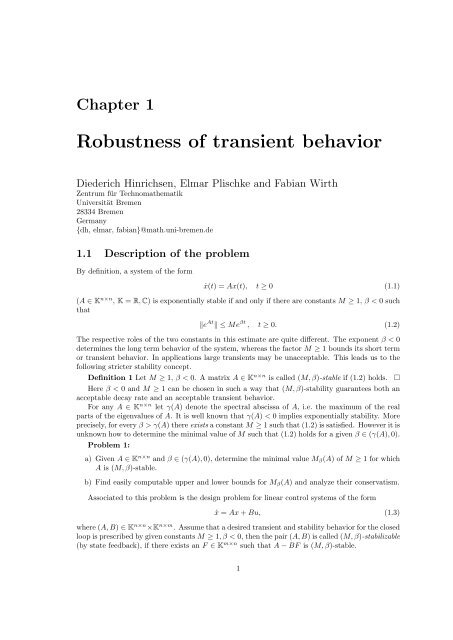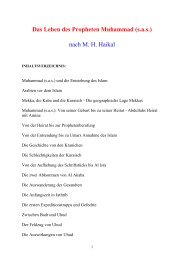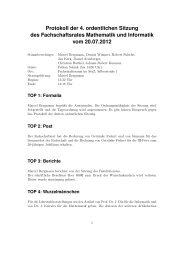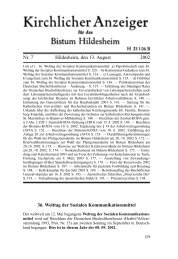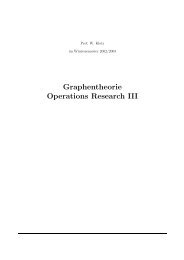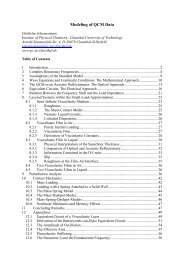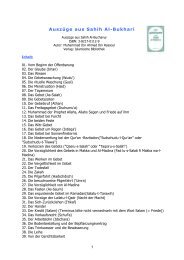Robustness of transient behavior - TU Clausthal
Robustness of transient behavior - TU Clausthal
Robustness of transient behavior - TU Clausthal
Create successful ePaper yourself
Turn your PDF publications into a flip-book with our unique Google optimized e-Paper software.
Chapter 1<br />
<strong>Robustness</strong> <strong>of</strong> <strong>transient</strong> <strong>behavior</strong><br />
Diederich Hinrichsen, Elmar Plischke and Fabian Wirth<br />
Zentrum für Technomathematik<br />
Universität Bremen<br />
28334 Bremen<br />
Germany<br />
{dh, elmar, fabian}@math.uni-bremen.de<br />
1.1 Description <strong>of</strong> the problem<br />
By definition, a system <strong>of</strong> the form<br />
˙x(t) = Ax(t), t ≥ 0 (1.1)<br />
(A ∈ K n×n , K = R, C) is exponentially stable if and only if there are constants M ≥ 1, β < 0 such<br />
that<br />
�e At � ≤ Me βt , t ≥ 0. (1.2)<br />
The respective roles <strong>of</strong> the two constants in this estimate are quite different. The exponent β < 0<br />
determines the long term <strong>behavior</strong> <strong>of</strong> the system, whereas the factor M ≥ 1 bounds its short term<br />
or <strong>transient</strong> <strong>behavior</strong>. In applications large <strong>transient</strong>s may be unacceptable. This leads us to the<br />
following stricter stability concept.<br />
Definition 1 Let M ≥ 1, β < 0. A matrix A ∈ K n×n is called (M, β)-stable if (1.2) holds. �<br />
Here β < 0 and M ≥ 1 can be chosen in such a way that (M, β)-stability guarantees both an<br />
acceptable decay rate and an acceptable <strong>transient</strong> <strong>behavior</strong>.<br />
For any A ∈ K n×n let γ(A) denote the spectral abscissa <strong>of</strong> A, i.e. the maximum <strong>of</strong> the real<br />
parts <strong>of</strong> the eigenvalues <strong>of</strong> A. It is well known that γ(A) < 0 implies exponentially stability. More<br />
precisely, for every β > γ(A) there exists a constant M ≥ 1 such that (1.2) is satisfied. However it is<br />
unknown how to determine the minimal value <strong>of</strong> M such that (1.2) holds for a given β ∈ (γ(A), 0).<br />
Problem 1:<br />
a) Given A ∈ K n×n and β ∈ (γ(A), 0), determine the minimal value Mβ(A) <strong>of</strong> M ≥ 1 for which<br />
A is (M, β)-stable.<br />
b) Find easily computable upper and lower bounds for Mβ(A) and analyze their conservatism.<br />
Associated to this problem is the design problem for linear control systems <strong>of</strong> the form<br />
˙x = Ax + Bu, (1.3)<br />
where (A, B) ∈ K n×n ×K n×m . Assume that a desired <strong>transient</strong> and stability <strong>behavior</strong> for the closed<br />
loop is prescribed by given constants M ≥ 1, β < 0, then the pair (A, B) is called (M, β)-stabilizable<br />
(by state feedback), if there exists an F ∈ K m×n such that A − BF is (M, β)-stable.<br />
1
2 CHAPTER 1. ROBUSTNESS OF TRANSIENT BEHAVIOR<br />
Problem 2:<br />
a) Given constants M ≥ 1, β < 0, characterize the set <strong>of</strong> (M, β)-stabilizable pairs (A, B) ∈<br />
K n×n × K n×m .<br />
b) Provide a method for the computation <strong>of</strong> (M, β)-stabilizing feedbacks F for (M, β)-stabilizable<br />
pairs (A, B).<br />
In order to account for uncertainties in the model we consider systems described by<br />
˙x = A∆x = (A + D∆E)x,<br />
where A ∈ K n×n is the nominal system matrix, D ∈ K n×ℓ and E ∈ K q×n are given structure<br />
matrices, and ∆ ∈ K ℓ×q is an unknown perturbation matrix for which only a bound <strong>of</strong> the form<br />
�∆� ≤ δ is assumed to be known.<br />
Problem 3:<br />
a) Given A ∈ K n×n , D ∈ K n×ℓ and E ∈ K q×n , determine analytically the (M, β)−stability<br />
radius defined by<br />
r (M,β)(A; D, E) = inf<br />
b) Provide an algorithm for the calculation <strong>of</strong> this quantity.<br />
�<br />
�∆� ∈ K ℓ×q , ∃τ > 0 : �e (A+D∆E)τ �<br />
βτ<br />
� ≥ Me . (1.4)<br />
c) Determine easily computable upper and lower bounds for r (M,β)(A; D, E).<br />
The two previous problems can be thought <strong>of</strong> as steps towards the following final problem.<br />
Problem 4: Given a system (A, B) ∈ K n×n × K n×m , a desired <strong>transient</strong> <strong>behavior</strong> described<br />
by M ≥ 1, β < 0, and matrices D ∈ K n×ℓ , E ∈ K q×n describing the perturbation structure,<br />
a) characterize the constants γ > 0 for which there exists a state feedback matrix such that<br />
r (M,β)(A − BF ; D, E) ≥ γ . (1.5)<br />
b) Provide a method for the computation <strong>of</strong> feedback matrices F such that (1.5) is satisfied.<br />
1.2 Motivation and history <strong>of</strong> the problem<br />
Stability and stabilization are fundamental concepts in linear systems theory and in most design<br />
problems exponential stability is the minimal requirement that has to be met. From a practical<br />
point <strong>of</strong> view, however, the <strong>transient</strong> <strong>behavior</strong> <strong>of</strong> a system may be <strong>of</strong> equal importance and is <strong>of</strong>ten<br />
one <strong>of</strong> the criteria which decide on the quality <strong>of</strong> a controller in applications. As such, the notion<br />
<strong>of</strong> (M, β)− stability is related to such classical design criteria as “overshoot” <strong>of</strong> system responses.<br />
In particular, if linear design is performed as a local design for a nonlinear system large <strong>transient</strong>s<br />
may result in a small domain <strong>of</strong> attraction. The relation between domains <strong>of</strong> attraction<br />
and <strong>transient</strong> <strong>behavior</strong> <strong>of</strong> linearizations at fixed points is an active field motivated by problems<br />
in mathematical physics, in particular, fluid dynamics, see [1, 10] and references therein. Related<br />
problems occur in the study <strong>of</strong> iterative methods in numerical analysis, see e.g. [3].<br />
We would like to point out that the problems discussed in this note give pointwise conditions<br />
in time for the bounds and are therefore different from criteria that can be formulated via integral<br />
constraints on the positive time axis. In the literature such integral criteria are sometimes also<br />
called bounds on the <strong>transient</strong> <strong>behavior</strong>, see e.g. [9] where interesting results are obtained for this<br />
case.<br />
Stability radii with respect to asymptotic stability <strong>of</strong> linear systems were introduced in [5] and<br />
there is a considerable body <strong>of</strong> literature investigating this problem. The questions posed in this<br />
note are an extension <strong>of</strong> the available theory ins<strong>of</strong>ar as the <strong>transient</strong> <strong>behavior</strong> is neglected in most<br />
<strong>of</strong> the available results on stability radii.
1.3. AVAILABLE RESULTS 3<br />
1.3 Available results<br />
For Problem 1 a number <strong>of</strong> results are available. Estimates <strong>of</strong> the <strong>transient</strong> <strong>behavior</strong> involving either<br />
quadratic Lyapunov functions or resolvent inequalities are known but can be quite conservative or<br />
intractable. Moreover, for many <strong>of</strong> the available estimates little is known on their conservatism.<br />
The Hille-Yosida Theorem [8] provides an equivalent description <strong>of</strong> (M, β)−stability in terms<br />
<strong>of</strong> the norm <strong>of</strong> powers <strong>of</strong> the resolvent <strong>of</strong> A. Namely, A is (M, β)-stable if and only if for all n ∈ N<br />
and all α ∈ R with α > β it holds that<br />
� (αI − A) −n � ≤<br />
M<br />
.<br />
(α − β) n<br />
While this condition is hard to check there is a classical, easily verifiable, sufficient condition using<br />
quadratic Lyapunov functions. Let β ∈ (γ(A), 0), if P > 0 satisfies the Lyapunov inequality<br />
A ∗ P + P A ≤ 2βP ,<br />
and has condition number κ(P ) := �P ��P −1 � ≤ M 2 then A is (M, β)-stable. The existence <strong>of</strong><br />
P > 0 satisfying these conditions may be posed as an LMI-problem [2]. However, it can be shown<br />
that if β < 0 is given and the spectral bound <strong>of</strong> A is below β then this method is necessarily<br />
conservative, in the sense that the best bound on M obtainable in this way is strictly larger than<br />
the minimal bound. Furthermore, experiments show that the gap between these two bounds can<br />
be quite large. In this context, note that the problem cannot be solved by LMI techniques since<br />
the characterization <strong>of</strong> the optimal M for given β is not an algebraic problem.<br />
There is a large number <strong>of</strong> further upper bounds available for �e At �. These are discussed and<br />
compared in detail in [4, 11], see also the references therein. A number <strong>of</strong> these bounds is also<br />
valid in the infinite-dimensional case.<br />
For Problem 2, sufficient conditions are derived in [7] using quadratic Lyapunov functions and<br />
LMI techniques. The existence <strong>of</strong> a feedback F such that<br />
P (A − BF ) + (A − BF ) ∗ P ≤ 2βP and κ(P ) = �P ��P −1 � ≤ M 2 , (1.6)<br />
or, equivalently, the solvability <strong>of</strong> the associated LMI problem, is characterized in geometric terms.<br />
This, however, only provides a sufficient condition under which Problem 2 can be solved. But the<br />
LMI problem (1.6) is far from being equivalent to Problem 2.<br />
Concerning Problem 3 differential Riccati equations are used to derive bounds for the (M, β)−<br />
stability radius in [6]. Suppose there exist positive definite Hermitian matrices P 0 , Q, R <strong>of</strong> suitable<br />
dimensions such that the differential Riccati equation<br />
has a solution on R+ which satisfies<br />
˙<br />
P − (A − βI)P − P (A − βI) ∗ − E ∗ QE − P DRD ∗ P = 0 (1.7)<br />
¯σ(P (t))/σ(P 0 ) ≤ M 2 , t ≥ 0.<br />
Then the structured (M, β)−stability radius is at least<br />
P (0) = P 0<br />
(1.8)<br />
r (M,β)(A; D, E) ≥ � σ(Q)σ(R) , (1.9)<br />
where ¯σ(X) and σ(X) denote the largest and smallest singular value <strong>of</strong> X. However, it is unknown<br />
how to choose the parameters P 0 , Q, R in an optimal way and it is unknown, whether equality can<br />
be obtained in (1.9) by an optimal choice <strong>of</strong> P 0 , Q, R.<br />
To the best <strong>of</strong> our knowledge no results are available dealing with Problem 4.
4 CHAPTER 1. ROBUSTNESS OF TRANSIENT BEHAVIOR
Bibliography<br />
[1] J.S. Baggett and L.N. Trefethen. Low-dimensional Models <strong>of</strong> Subcritical Transition to Turbulence.<br />
Physics <strong>of</strong> Fluids 9:1043–1053, 1997.<br />
[2] S. Boyd, L. El Ghaoui, E. Feron, and V. Balakrishnan. Linear Matrix Inequalities in Systems<br />
and Control Theory, volume 15 <strong>of</strong> Studies in Applied Mathematics. SIAM, Philadelphia, 1994.<br />
[3] T. Braconnier and F. Chaitin-Chatelin. Round<strong>of</strong>f induces a chaotic <strong>behavior</strong> for eigensolvers<br />
applied on highly nonnormal matrices. Bristeau, M.-O. (ed.) et al., Computational science for<br />
the 21st century. Symposium, Tours, France, May 5–7, 1997. Chichester: John Wiley & Sons.<br />
43-52 (1997).<br />
[4] M. I. Gil’. Stability <strong>of</strong> Finite and Infinite Dimensional Systems. Kluwer Academic Publishers,<br />
Boston, 1998.<br />
[5] D. Hinrichsen and A. J. Pritchard. Stability radius for structured perturbations and the algebraic<br />
Riccati equation. Systems & Control Letters, 8:105–113, 1986.<br />
[6] D. Hinrichsen, E. Plischke, and A. J. Pritchard. Liapunov and Riccati equations for practical<br />
stability. In Proc. European Control Conf. ECC-2001, Porto, Portugal, (CD-ROM), pp. 2883–<br />
2888, 2001.<br />
[7] D. Hinrichsen, E. Plischke, and F. Wirth. State Feedback Stabilization with Guaranteed Transient<br />
Bounds. To appear in Proceedings <strong>of</strong> MTNS-2002, Notre Dame, IN, USA, August 2002.<br />
[8] A. Pazy. Semigroups <strong>of</strong> Linear Operators and Applications to Partial Differential Equations.<br />
Springer-Verlag, New York, 1983.<br />
[9] A. Saberi, A.A. Stoorvogel, and P. Sannuti. Control <strong>of</strong> Linear Systems with Regulation and<br />
Input Constraints. Springer-Verlag, London, 2000.<br />
[10] L. N. Trefethen. Pseudospectra <strong>of</strong> linear operators. SIAM Review, 39(3):383–406, 1997.<br />
[11] K. Veselić. Bounds for exponentially stable semigroups. preprint Fernuniversität Hagen,<br />
Hagen, Germany, 2001.<br />
5


